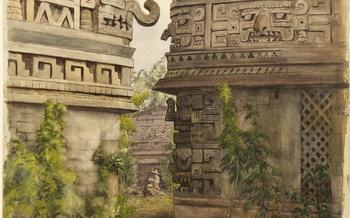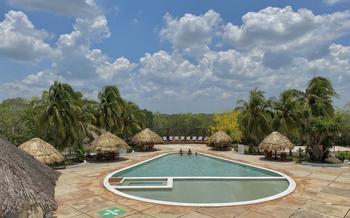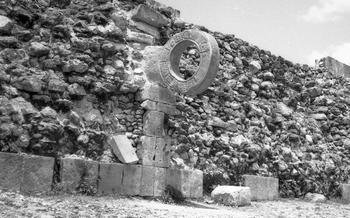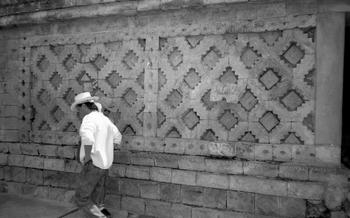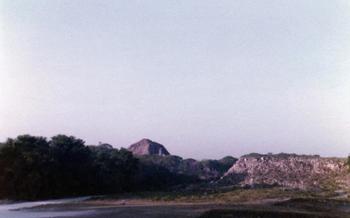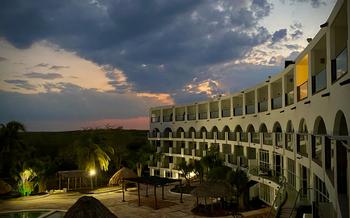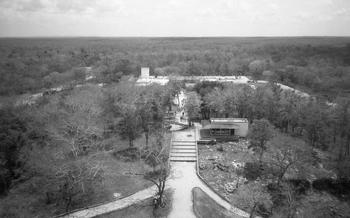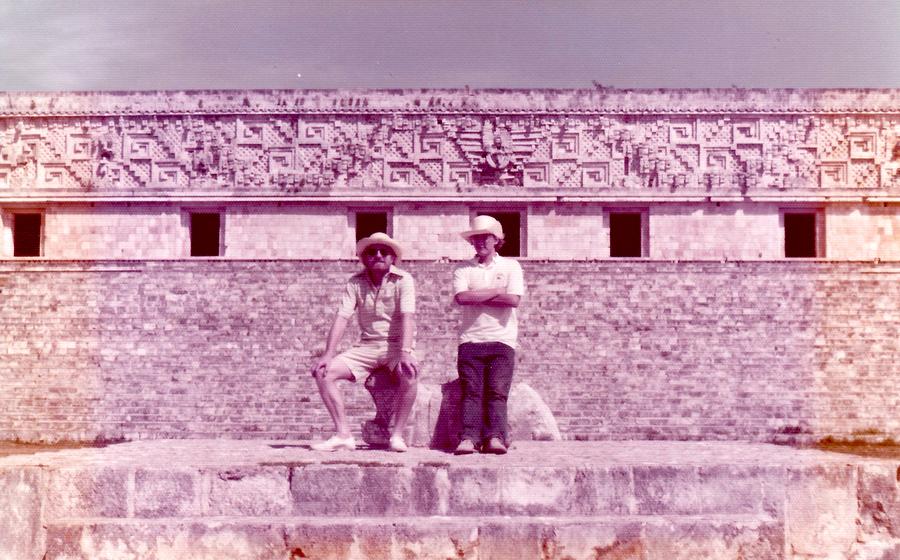
Cenote Xlacah at Dzibilchaltun
- Uxmal - A Journey into Mayan History
- Cenote Xlacah - An Enchanting Natural Wonder
- Getting to Dzibilchaltun: Unveiling the Ancient Mayan City
- Exploring Dzibilchaltun's Ruins
- Unveiling the Ancient Mayan Sacbe
- Cultural Immersion at the Museum
- Local Cuisine and Culinary Delights
- Shopping for Mayan Handicrafts
- Witnessing the Mayan Ball Game: A Thrilling Spectacle
- Off-the-Beaten-Path Adventures
- Wildlife Encounters in the Jungle
- Exploring Nearby Attractions:
- Planning Your Visit
- Insider Tip: A Unique Perspective
Uxmal - A Journey into Mayan History
Uxmal, a majestic ancient city nestled in the heart of the Yucatán Peninsula, Mexico, stands as a testament to the ingenuity and architectural prowess of the Maya civilization. Renowned for its well-preserved structures, unique architectural styles, and captivating history, Uxmal offers visitors a glimpse into the grandeur of a once-thriving metropolis.
The city's name, derived from the Mayan word "Oxmal," translates to "thrice-built," alluding to the cyclical nature of Mayan mythology and their belief in the constant rebuilding and renewal of the world. Uxmal's strategic location, situated on an ancient trade route, contributed to its growth and prominence as a center of commerce and cultural exchange.
Among the most striking features of Uxmal are its distinctive architectural elements, including the use of corbelled arches, intricate stone carvings, and elaborate facades adorned with masks, geometric patterns, and depictions of deities. The Pyramid of the Magician, the city's most iconic structure, showcases these architectural marvels, rising majestically from a broad platform and featuring a series of terraces and chambers that served as temples and observatories.
Uxmal's rich history is intertwined with Mayan mythology, rituals, and political power. The city flourished during the Late Classic period (600-900 AD), reaching its peak around 850 AD. It served as the capital of the powerful Xiu dynasty, who ruled over a vast territory in the northern Yucatán region. Uxmal's decline coincided with the rise of the neighboring city of Chichén Itzá, and by the 12th century, it was largely abandoned, leaving behind a legacy of architectural wonders that continue to captivate visitors to this day.
Cenote Xlacah - An Enchanting Natural Wonder
The Cenote Xlacah, located within the archaeological site of Dzibilchaltun, is a breathtaking natural wonder that offers a refreshing respite from the heat and history of the ancient Maya city. Formed by the collapse of a limestone bedrock, this cenote boasts crystal-clear waters that shimmer in shades of turquoise and emerald. Its depths reveal a diverse ecosystem teeming with aquatic life, including colorful fish, turtles, and even the occasional crocodile.
Beyond its geological significance, the Cenote Xlacah holds cultural and mythological importance for the Maya. Cenotes were considered sacred portals to the underworld, and the Maya believed that these natural wells connected the earthly realm with the realm of the gods. According to Mayan mythology, the cenotes were also believed to be the homes of water spirits known as aluxes, who were mischievous creatures that could bring both good luck and misfortune.
Getting to Dzibilchaltun: Unveiling the Ancient Mayan City
Dzibilchaltun, home to the enchanting Cenote Xlacah, is situated in the heart of the Yucatán Peninsula, approximately 15 kilometers north of the city of Mérida. Its strategic location makes it easily accessible from major cities and tourist hubs in the region. Travelers can embark on a hassle-free journey to Dzibilchaltun by choosing from various transportation options.
One convenient way to reach Dzibilchaltun is by renting a car, which offers the freedom to explore the area at your own pace. Rental cars are readily available at the Mérida International Airport or within the city. The drive from Mérida to Dzibilchaltun takes about 30 minutes, following well-maintained roads.
For those without a driver's license or preferring a more relaxed mode of transportation, organized tours are an excellent option. Numerous tour operators in Mérida offer day trips to Dzibilchaltun, including guided visits to the archaeological site and Cenote Xlacah. These tours typically provide transportation to and from your hotel, ensuring a seamless and enjoyable experience.
To make the most of your journey, consider departing early in the morning to avoid the midday heat and crowds. Whether you choose to drive yourself or join an organized tour, getting to Dzibilchaltun is a breeze, setting the stage for an unforgettable exploration of this ancient Mayan city and its natural wonders.
Exploring Dzibilchaltun's Ruins
Dzibilchaltun, an ancient city of the Maya civilization, boasts a rich history and significant archaeological remains. Immerse yourself in the legacy of the Maya as you explore the ruins of this once-vibrant metropolis.
- Pre-Columbian History and Significance:
- Dzibilchaltun's origins date back to the Pre-Classic period (c. 1000 BC - 250 AD), serving as a vital trading hub and ceremonial center.
- The city reached its peak during the Classic period (250-900 AD), becoming a prominent center of art, culture, and commerce.
-
Its strategic location along trade routes and proximity to the coast facilitated the exchange of goods and ideas with other Maya city-states.
-
Notable Structures and Features to Look Out For:
- The Temple of the Seven Dolls:
- One of the most iconic structures, renowned for its unique architectural features and intricate stucco decorations.
- Its name derives from the seven female figurines discovered within the temple, representing important deities or ancestors.
- The Great Plaza:
- The heart of the city, surrounded by impressive structures such as the Temple of the Seven Dolls and the Governor's Palace.
- Served as a gathering place for religious ceremonies, public events, and market activities.
-
The Cenote Xlacah:
- A natural sinkhole located within the archaeological site, providing a refreshing oasis and a glimpse into the Maya's water management system.
- Believed to have been used for ceremonial purposes and as a source of freshwater.
-
The Temple of the Seven Dolls and its Fascinating Story:
- The temple's intricate stucco facade depicts various scenes and figures, including a procession of seven women.
- Archaeologists believe these women represent important deities or ancestors, possibly related to the city's royal lineage.
- The temple's architectural design and iconography offer valuable insights into the religious beliefs and social structure of the Maya civilization.
Unveiling the Ancient Mayan Sacbe
As you wander through the archaeological site of Dzibilchaltun, you'll encounter an intriguing network of ancient roads known as sacbe. These elevated causeways, constructed from limestone and rubble, once served as vital transportation routes, connecting the various parts of the city and beyond.
The Maya built these sacbe with remarkable precision, using surveying techniques to ensure straight paths that often extended for several kilometers. Their construction required immense labor and engineering skill, testament to the advanced capabilities of the Mayan civilization.
Exploring these sacbe offers a unique perspective into the urban planning and infrastructure of the ancient Maya. Imagine the bustling activity that once took place along these pathways, as people, goods, and ideas flowed between different parts of the city.
Follow the sacbe to discover hidden corners of Dzibilchaltun, uncovering new structures and gaining a deeper appreciation for the interconnectedness of this once-thriving metropolis.
Cultural Immersion at the Museum
Dzibilchaltun's museum, nestled within the archaeological site, offers an immersive journey into the captivating world of the ancient Maya. As you step inside, you'll be greeted by a treasure trove of artifacts, interactive displays, and educational programs that bring the Maya civilization to life.
The museum's collection showcases a vast array of Mayan artifacts, from intricately carved stone sculptures to delicate ceramic vessels. These relics provide a tangible connection to the lives and customs of this enigmatic people. Through informative exhibits, you'll learn about their advanced agricultural techniques, sophisticated writing system, and complex religious beliefs.
Don't miss the museum's interactive displays, which allow you to engage with the Maya culture in a hands-on way. Try your hand at grinding corn using a traditional metate, decipher Mayan hieroglyphs, or immerse yourself in a virtual reality experience that transports you back in time.
The museum also offers guided tours led by knowledgeable experts who can provide insights into the significance of the artifacts and the history of Dzibilchaltun. These tours are an excellent way to deepen your understanding of the Maya civilization and gain a greater appreciation for their rich cultural heritage.
Local Cuisine and Culinary Delights
A journey to Uxmal and Dzibilchaltun is not complete without savoring the authentic flavors of Mayan cuisine. The region boasts a rich culinary tradition that has been passed down through generations, showcasing a blend of ancient Mayan recipes and contemporary influences. Must-try dishes include cochinita pibil, a slow-cooked pork dish marinated in achiote paste and wrapped in banana leaves; panuchos, fried tortillas topped with refried beans, turkey or chicken, and pickled red onions; and salbutes, similar to panuchos but with a crispy tortilla base. Be sure to indulge in fresh seafood delicacies, such as ceviche and tikin xic, a grilled fish marinated in achiote and wrapped in banana leaves. For a sweet treat, try marquesitas, crispy crepes filled with Edam cheese and Nutella or cajeta, a caramel sauce. Explore the local markets or visit traditional restaurants to immerse yourself in the culinary delights of the region.
Shopping for Mayan Handicrafts
Immerse yourself in the vibrant world of Mayan artistry and craftsmanship as you explore the local markets and shops of Dzibilchaltun. Discover a treasure trove of handmade goods, from intricately woven textiles and colorful pottery to finely crafted wooden carvings and intricate silver jewelry. Each piece tells a story, embodying the rich cultural heritage and traditions of the Maya people.
Support local artisans by purchasing their unique creations, helping to preserve and promote their traditional skills. Engage with the friendly vendors, learn about the techniques and inspiration behind their work, and find one-of-a-kind souvenirs to cherish as memories of your time in Dzibilchaltun.
Don't miss the opportunity to witness live demonstrations of traditional Mayan crafts, such as weaving, pottery making, and wood carving. These immersive experiences offer a glimpse into the artistry and dedication of the local artisans, allowing you to appreciate the intricate processes involved in creating these beautiful handmade goods.
Before you make a purchase, take the time to browse and compare prices at different shops. Bargaining is a common practice in local markets, and you can often find great deals if you're willing to negotiate. Be respectful and friendly, and enjoy the interaction as part of the shopping experience.
Remember, your purchases not only support local artisans but also contribute to the preservation of Mayan cultural traditions. By choosing authentic, handmade souvenirs, you're helping to keep these traditions alive and ensuring that future generations can appreciate the beauty and craftsmanship of Mayan art.
Witnessing the Mayan Ball Game: A Thrilling Spectacle
The ancient Mayan ball game, known as Pok-ta-Pok, was a significant cultural and religious practice in Mesoamerica. Played with a solid rubber ball, the game involved two teams competing to pass the ball through stone hoops attached to the walls of a specially designed court. The rules were complex, with the aim being to score points by hitting the ball through the hoops while avoiding being hit by the opposing team's players.
Uxmal was one of the major centers for the Mayan ball game, and visitors can still witness the grandeur of the ancient court today. The Great Ball Court is an impressive sight, with its towering stone walls and sloped playing field. Modern-day reenactments and demonstrations of the game are often held, allowing visitors to experience the thrill and excitement of this ancient sport.
Watching the Mayan ball game is a captivating experience that transports visitors back in time. The skill, agility, and athleticism of the players are awe-inspiring, and the atmosphere is electric as the teams battle for victory. It's a must-see for anyone interested in Mayan culture and history.
Off-the-Beaten-Path Adventures
While Uxmal and Cenote Xlacah are must-visit attractions, venturing off the beaten path offers a unique opportunity to explore lesser-known gems. Hidden cenotes, nestled deep within the jungle, await discovery, offering a serene and tranquil atmosphere. These secluded spots provide an escape from the crowds and allow for a more intimate connection with nature. Explore the ancient ruins of nearby archaeological sites, such as Kabah or Sayil, which offer a glimpse into the rich Mayan history of the region. Discovering these hidden treasures creates a personalized and memorable travel experience, allowing you to uncover the true essence of the Yucatan Peninsula.
Wildlife Encounters in the Jungle
Venturing into the lush jungles surrounding Uxmal and Dzibilchaltun offers a chance to connect with nature and witness the incredible biodiversity of the region. Keep your eyes peeled for exotic birds, such as toucans, parrots, and hummingbirds, flitting through the vibrant foliage. Spider monkeys and howler monkeys swing playfully from the treetops, providing a glimpse into the arboreal world.
Be on the lookout for reptiles like iguanas basking in the sun or stealthy snakes slithering through the undergrowth. The jungle's ecosystem is a haven for a diverse array of wildlife, from tiny insects to larger mammals like deer and tapirs. Remember to practice responsible wildlife observation by maintaining a respectful distance and avoiding disturbing their natural habitats.
Exploring Nearby Attractions:
Beyond Uxmal and Cenote Xlacah, the Yucatán Peninsula offers a treasure trove of other captivating destinations. Embark on a journey to discover the ancient Mayan cities of Chichén Itzá, Tulum, and Cobá, each boasting unique architectural marvels and rich histories. Immerse yourself in the vibrant colonial cities of Mérida and Valladolid, where colorful buildings, bustling markets, and delectable cuisine await. Explore the natural wonders of the region, including the stunning beaches of the Riviera Maya, the biodiverse Sian Ka'an Biosphere Reserve, and the mystical Río Lagartos, home to a diverse array of wildlife, including flamingos and crocodiles. Create a well-rounded travel experience by combining the exploration of Uxmal and Cenote Xlacah with visits to these nearby attractions, ensuring an unforgettable and enriching adventure.
Planning Your Visit
Proper planning ensures a smooth and enjoyable visit to Uxmal and Cenote Xlacah. The best time to visit is during the dry season from November to April, when the weather is pleasant and sunny. Avoid the peak tourist season from December to February if you prefer a quieter experience. Pack comfortable clothing, sturdy shoes for exploring ruins and cenotes, a swimsuit, sunscreen, insect repellent, and a hat to protect yourself from the sun. Make sure to bring a camera to capture the stunning scenery and your adventures. Booking accommodations and transportation in advance, especially during peak season, is advisable to secure your preferred options. With careful planning, you can create a memorable and hassle-free trip to these incredible destinations.
Insider Tip: A Unique Perspective
For an unforgettable experience, plan your visit to Uxmal and Cenote Xlacah during the spring or autumn equinox. During these times, the sun aligns perfectly with the Pyramid of the Magician, creating a mesmerizing spectacle that showcases the architectural brilliance of the ancient Maya. As the sun rises, its rays illuminate the pyramid's corners, casting sharp shadows that trace the building's contours. This phenomenon is a testament to the Maya's deep understanding of astronomy and their ability to integrate celestial events into their architecture. Witnessing this alignment is a truly awe-inspiring experience that offers a unique perspective on the legacy of this ancient civilization.

